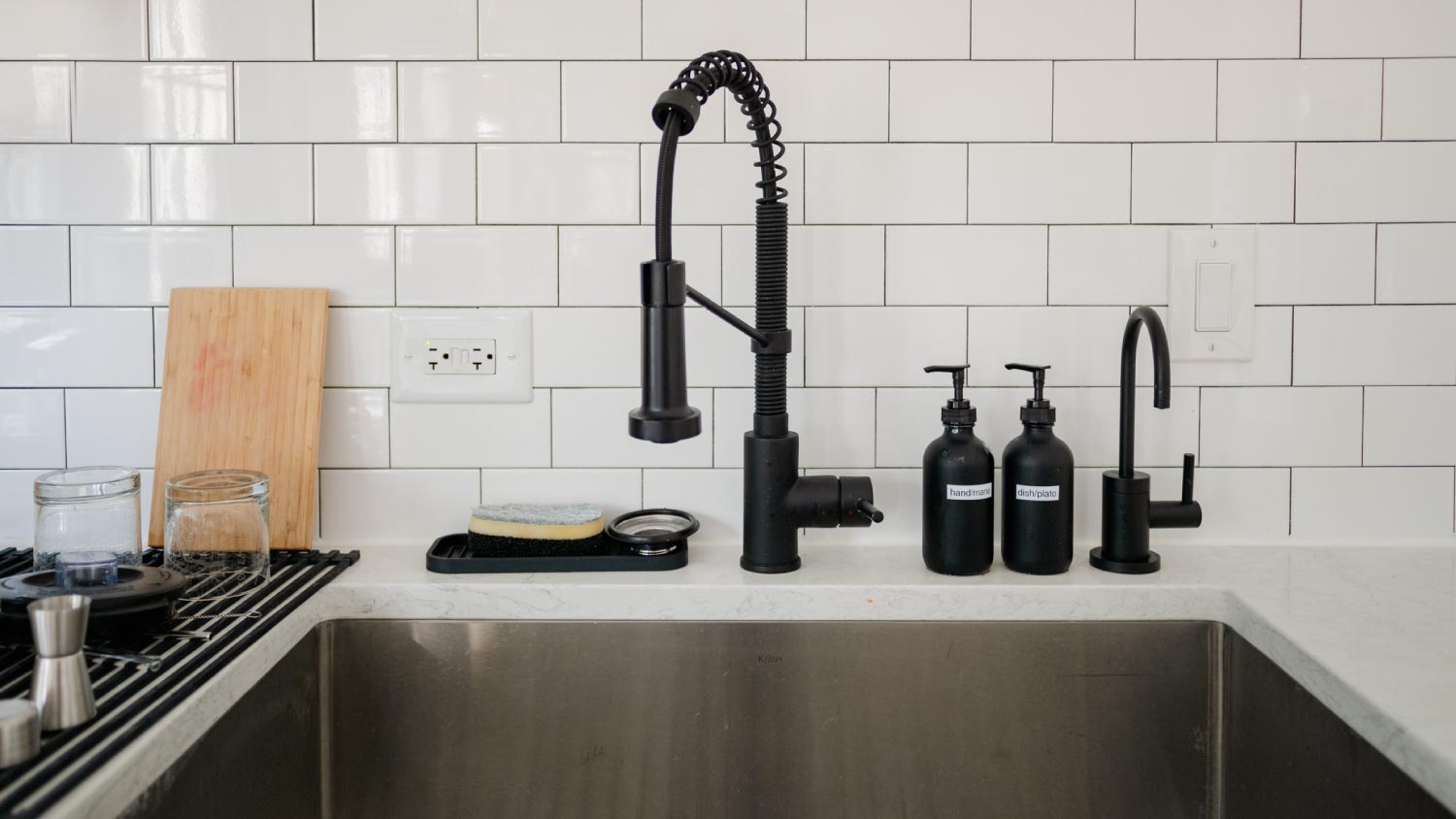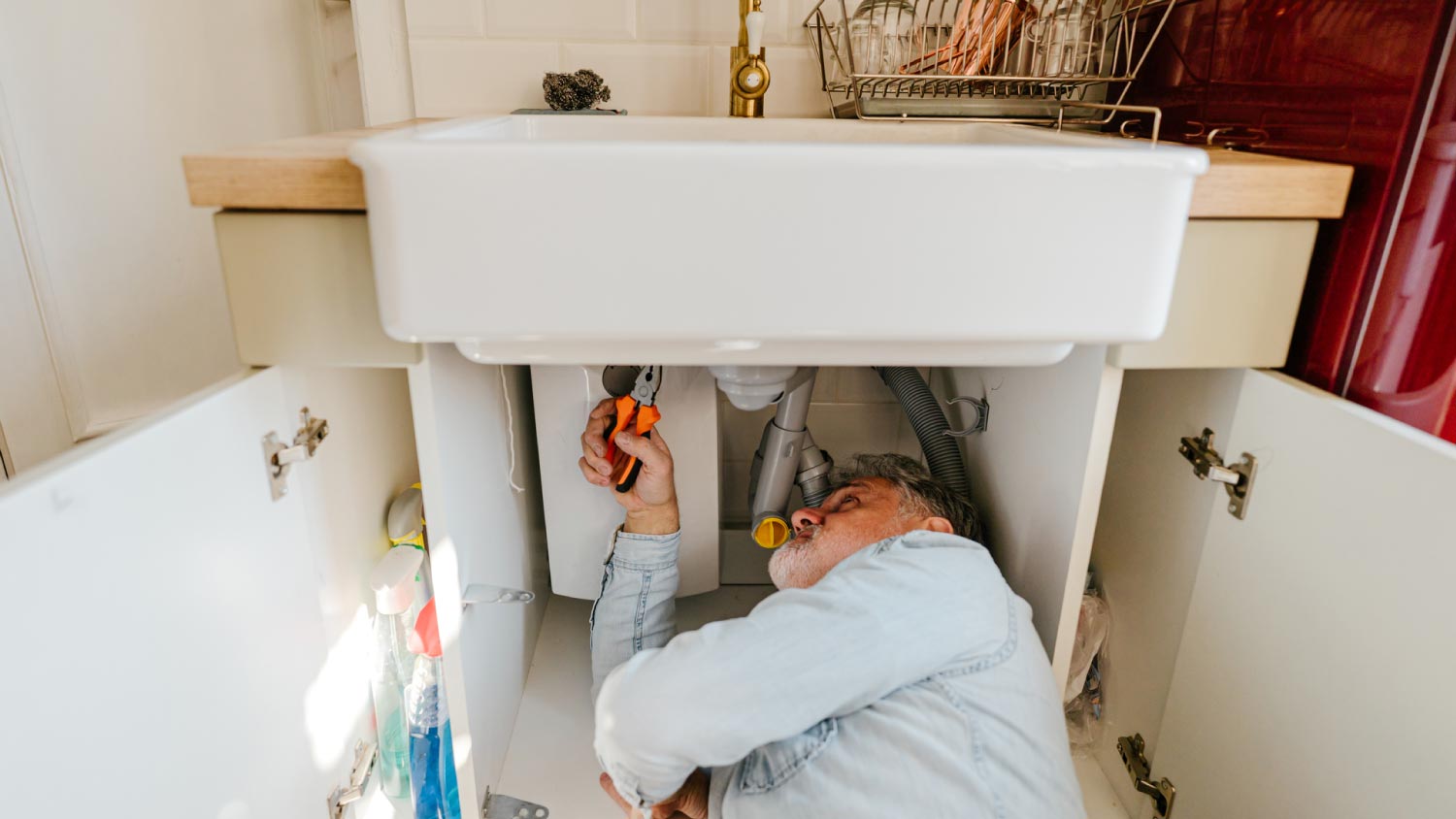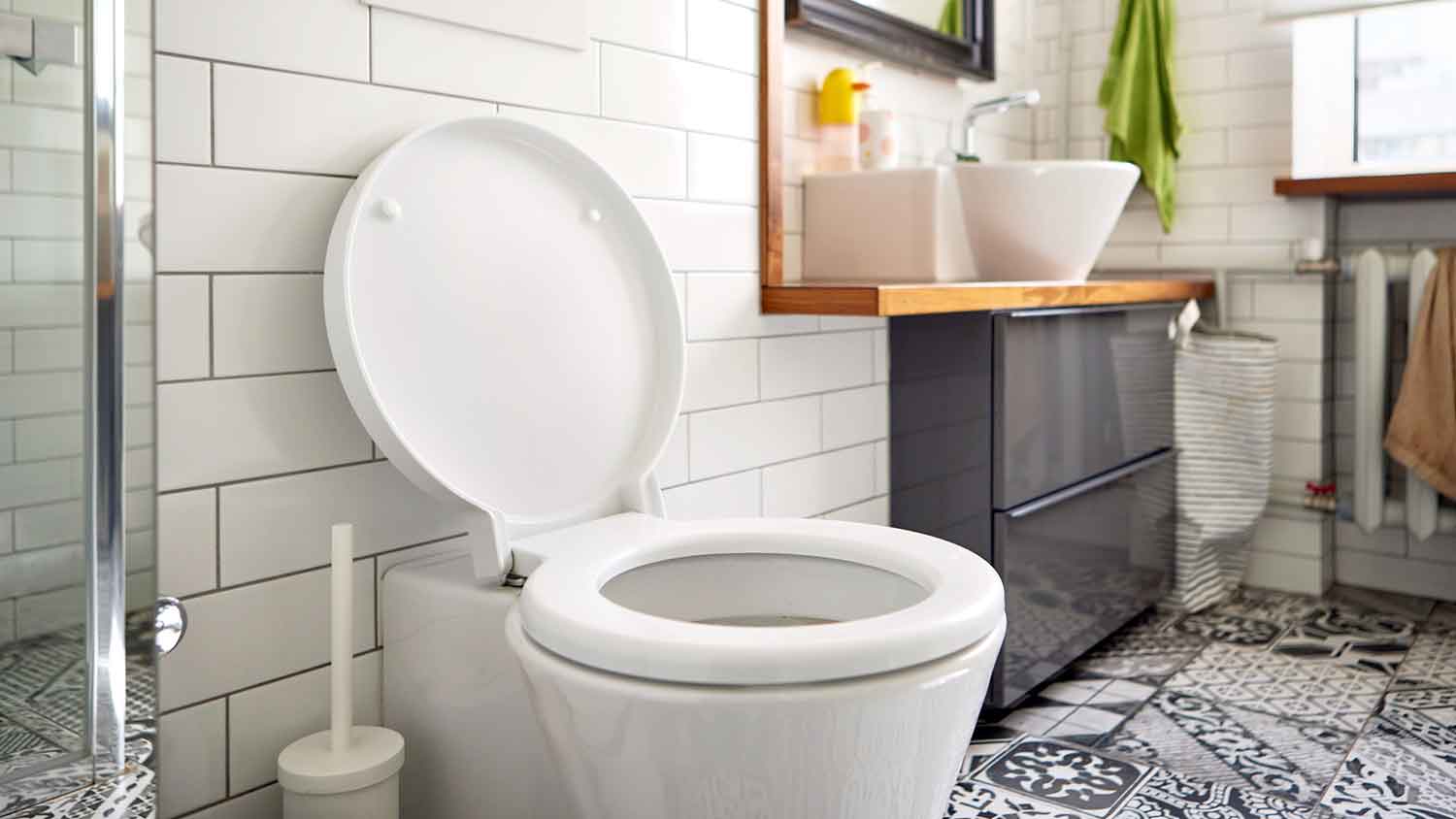Kitchen Flooding? Here's How to Get Out of Hot Water Fast
Don't get swept away by the panic of a flooded kitchen—get to the bottom of it with these tips


If you think of the plumbing in your house as a subway system, then your kitchen is Grand Central Station. Water flows through the sink, dishwasher, garbage disposal, and even the refrigerator—and each of these items has the potential to break, clog, and send water rushing all over your kitchen floor. If you've woken up to the dreaded kitchen flood and aren't sure what to do first, we've got you covered.
First Things First: Steps to Manage Kitchen Flooding
Before we jump into how kitchen floods can happen in the first place, let's start with a safety note about the initial steps to take to control your kitchen flood.
Turn off the Water and Electricity
Never step into flood waters without turning off your electrical circuits. Your kitchen houses several appliances—from small toasters to large dishwashers—so a floor full of water is dangerous. Flip off the circuit breakers to your kitchen and any rooms potentially affected by the water.
It's also important to turn off your water supply valve. The valve is typically located either in your basement, crawlspace, or near your outdoor hot water heater.
Focus on Immediate Flood Control
Whether there's a mini pond around your kitchen faucet or several inches of water on your kitchen floor, it's important to take care of the standing water ASAP. Water damage can be costly to repair, especially if it leads to mold or rot.
While you should always call a professional plumber to address major flooding, there are a few things you can do to handle flood damage in the meantime.
Pump out the water with a sump pump or a dry vac and mop up as much moisture as possible. Keep all your windows open and add fans and dehumidifiers once the bulk of the water is gone. You'll likely need a water damage restoration team down the line but focus on damage control in the short term.
Find the Culprit: What Caused Your Kitchen to Flood?
Once the flood area is under control, it's time to assess what happened. Let's say you found one of the following scenarios:
A sink full of water even though the sink was turned off
Water surrounding the dishwasher or refrigerator
Flooding under your sink or coming through base kitchen cabinets
Flooded countertops
Unless there is an outside force at work—such as a recent storm that came through your doors and windows—kitchen flooding typically comes from one of five places:
The kitchen sink faucet
The kitchen sink drain
The refrigerator
The dishwasher
Your sink attachments
Let's walk through each major source of kitchen flooding and what to do about it.
Kitchen Sink Faucet

Let's clear something up: kitchen faucets, housings, and their attached pipes can leak even when the sink isn’t on. There are several places along the path from your water supply line to the spout where things can go wrong. You may have:
Corroded pipes or gaskets around your water supply line
Worn-out gaskets or washers where your pipes meet the faucet
A cracked or poorly sealed faucet housing
A cracked or loosely connected P-trap
In other words, anything along the water's journey to your sink can loosen or crack. Even newer PVC pipes have the potential to develop small cracks that you don't notice until there's flooring.
What to Do About It
Small sink leaks are easy DIY fixes. Check the gasket and washer at the east junction point between the wall under the sink and the spout of your faucet. If you cannot spot the leak with a quick look, it's time to hire a plumber to ensure the leak is not coming from a pipe hidden deep within the walls.
If you need a new kitchen faucet, expect the replacement to cost between $160 and $345, including labor.
Kitchen Sink Drain

The kitchen drain deserves its own category. When kitchen flooding stems from water coming up through your drain—yes, the wrong direction—you may be dealing with a clog. Clogs can happen in the P-trap below your sink, specifically at the junction of your dishwasher or garbage disposal, or further down the line.
It helps to understand how your home's plumbing system works. If one drainage pipe becomes clogged in other areas of your home, wastewater can back up—we know, gross—and escape elsewhere, such as your kitchen sink. The clog's location will depend on the unique structure of your home's plumbing.
What to Do About It
Check the drain for a clog by starting with the traditional DIY unclogging methods, such as pouring boiling water down the drain and using a sink plunger. You can also unscrew the P-trap to check whether there’s something stuck in the major curve of the sink. Once again, if you don't spot a clog in the drain, call a plumber or water main specialist to see if the backup is coming from elsewhere in the house.
Refrigerator
Moving on to the appliance troublemakers; water dispensers and ice makers can cause unexpected kitchen flooding. There are a few common issues with icemakers, but a loose water line is one of the most common. These water line hoses can also crack easily, especially if you still have the same one that came with your fridge.
What to Do About It
Find the water line hose in the back or bottom of your refrigerator to ensure it is properly connected, void of cracks, and unclogged. You may also need to change the filter or replace the system if it's continuously causing issues.
Dishwasher
Dishwashers handle large water capacities—between four and six gallons for each run. If you have a worn door seal, broken or loose water hose, or a clogged drain, the water has nowhere else to go but out. Remember that a clogged dishwasher can also cause water to back up in your sink since they typically share a drainage pipe.
What to Do About It
You can assess the situation yourself before calling a dishwasher repair team. If your dishwasher won't drain, for example, check that the water line hose (located either under your sink or behind your dishwasher) is not clogged, disconnected, or broken. The hose connects to the dishwasher pump, which can also become clogged. You can also double-check that your garbage was not recently improperly installed to drain into your dishwasher.
Sink Attachments
Last but not least, there are the fancy attachments to your sink that either filter drinking water or grind up food waste.
There are many misconceptions about what you can put down a garbage disposal, and common things like coffee grounds and eggshells can cause them to clog or the motor to fail. Clogged garbage disposals can lead to a buildup of pressure and water in your drainage pipes, sending water up through your sink or any cracked pipe down the line it can find.
If you spot water coming from under your sink, but all your pipes are intact, the casing of your water filtration system or the attached hose could be the cause of your flood.
What to Do About It
Deep clean your garbage disposal to start. This method ensures that there isn't any remaining buildup or major malfunctions when draining. Lastly, take a look at your water filtration system under your sink to see whether water drips from this particular area when you turn the water back on.
If the unfortunate flood affected your tiles, walls, or even your kitchen cabinets, hire a kitchen remodeler to restore the kitchen of your dreams—without the faulty pipe, hose, or appliance this time.





- Gas Plumbers
- Plumbing Repairs
- Sump Pump Installation
- Wood & Pellet Stove Repair
- Shower Repair
- Wood Stove Services
- Emergency Plumbers
- Fire Sprinkler Contractors
- Perc Test Companies
- Toilet Repair & Installation
- Boiler Repair
- Sewer Line Repair
- Faucet Repair
- Main Drain Camera Companies
- Foundation Drain Installation
- French Drains
- Bathtub Replacement
- Subcontractors
- Storm Drain Contractors
- Affordable Plumbing
- Plumbing & Heating Companies
- Bathroom Repair Services
- Sink Installation
- Commercial Plumber
- Barndominium Builders
- Water Line Repair
- Faucet Installation
- Water Line Installation
- Leak Detection
- All the Parts of Kitchen Sink Plumbing You Need to Know
- A Complete Guide to the Parts of a Sink and How They Keep Things Flowing
- How to Install a Sink: A Step-by-Step Guide
- How to Unclog a Double Kitchen Sink With Standing Water
- 10 Most Common Plumbing Problems Every Homeowner Should Know
- 18 Common Plumbing Problems and How to Resolve Them
- Water Under Sink but No Leak? 9 Potential Causes and How to Find Them
- 7 Reasons Why Water Is Rising Through Your Floor—And How to Fix Them
- How to Unclog a Sink: 10 Ways to Beat Tough Kitchen Clogs and Make Sure They Never Return
- 3 Reasons Why Your Dishwasher Won’t Drain










